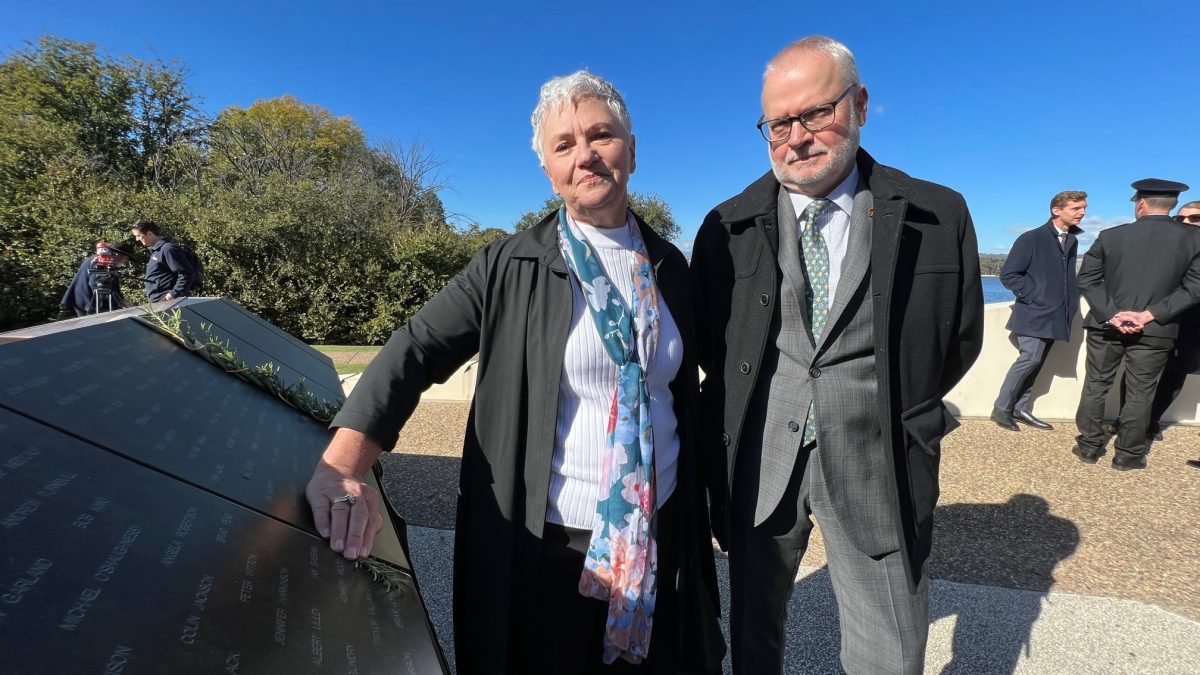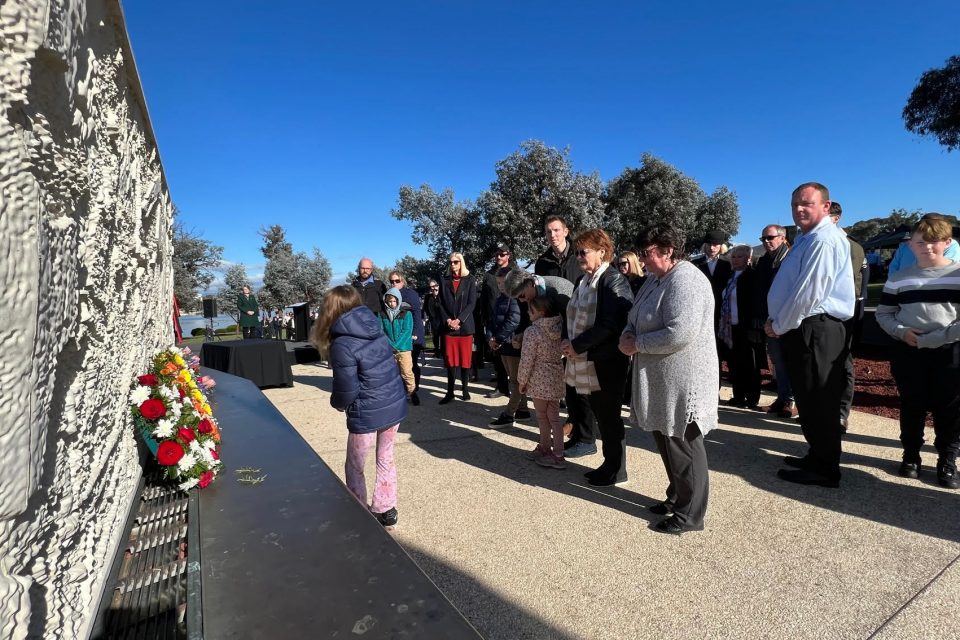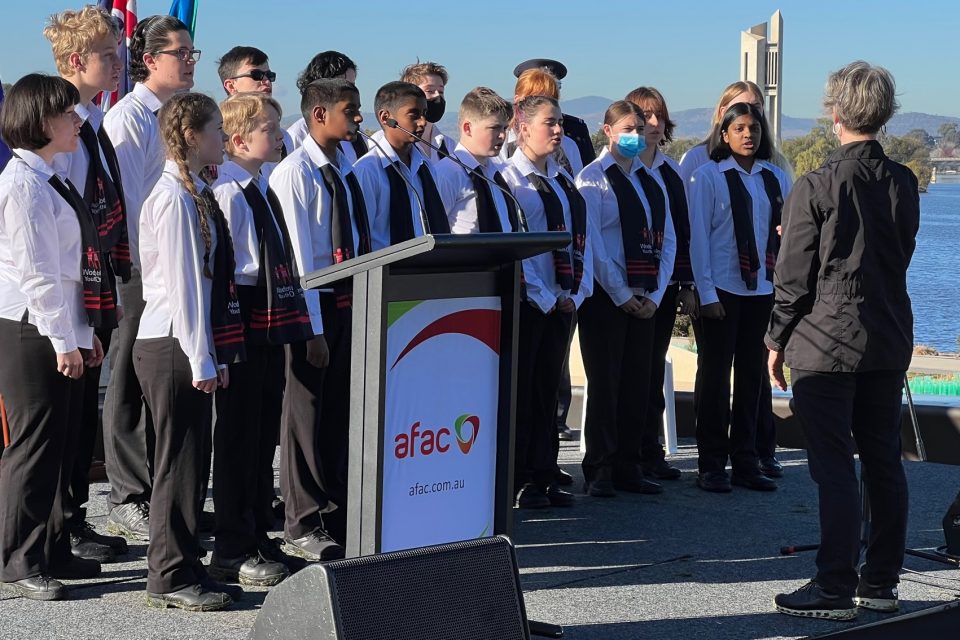
Robyn Wood presses her hand against her late husband’s name, engraved into the National Emergency Service Memorial in Canberra. Photo: Gary Hooker AFSM.
As Kenneth Wood’s name was added to the National Emergency Services Memorial in Canberra, his widow urged for more to be done to prevent firefighter deaths.
ACT Fire and Rescue firefighter Kenneth Wood died in 2017 after being diagnosed with colorectal, liver, lung and secondary lung cancer.
Robyn Wood was presented with a memorial medallion acknowledging her husband’s service on 6 May before she joined the United Firefighters Union to demand the ACT Government introduce health screening for Canberra firefighters.
“Ken experienced a toluene diisocyanate [toxic chemical] spill on the Federal Highway in 1982,” she said. He proved under firefighters’ presumptive workers’ compensation legislation that his disease and subsequent death were caused by his occupation.
“He and his fellow firefighters, assisted by the United Firefighters Union, fought a legal battle for 16 years to win some small amount of workers’ compensation,” Mrs Wood said.
“While the compensation scheme has improved since, and firefighter uniforms, foams, trucks and practices have all improved, firefighters are getting cancer at higher rates than ever.
“With all this in mind, it is my greatest wish that we keep challenging governments to put into place comprehensive health screening of all firefighters throughout their careers. Health screening to detect early signs of cancers might well prevent early death. Early intervention increases the chance of survival and cure.”






Monash University undertook the Australian Firefighters’ Health Study, which was funded by participating members of the Australasian Fire and Emergency Service Authorities Council (AFAC) and the Department of Defence.
The final report was published in 2014. It found that “the cancer mortality risk for paid firefighters was comparatively higher than the risk for other major causes of death, although still reduced compared to that of the Australian population”.
It stated working populations tend to be healthier than the general population, which could be because of fitness standards within the industry.
“For male career full-time firefighters compared to the Australian population, overall cancer incidence was significantly raised for the group as a whole and for those who had worked for longer than 20 years,” the report said.
It found rates of prostate and kidney cancers were elevated, as was the risk of melanoma, while there was “some evidence” of an increase in digestive system cancers.
In some cases, risk was elevated depending on the types of incidents the firefighters would generally respond to and how long the firefighters had been in service.
For female career full-time firefighters, the study stated there were “too few deaths or cancer cases for meaningful analyses”.
Mrs Wood said annual health screenings for Canberra’s firefighters would improve their health and chances of survival if cancer was detected and result in fewer workplace compensation claims.
“If we can reduce the risk of firefighter cancer, Ken would be pleased to know that his suffering was not in vain,” she said.
Police and Emergency Services Minister Mick Gentleman said the memorial service was a chance to reflect on the courage and sacrifice of those who had lost their lives. He was grateful Kenneth’s name could be added to the memorial wall.
“As Minister, I am always committed to ensuring the health and safety of our frontline responders,” he said.
“The ACT Government agreed to health screenings for firefighters in the 2020 enterprise bargaining agreement and looks forward to finalising the proposed implementation timetable with the United Firefighters Union.”
United Firefighters Union also called for the number of cancers covered by firefighter presumptive legislation to be expanded from 12 to 19.
President Greg McConville said thyroid, pancreatic, skin, cervical, ovarian, penile and lung cancers needed to be added to the list.
“The addition of cervical and ovarian cancer to presumptive legislation is particularly important. With a growing number of women becoming firefighters, it’s critical that we put in place measures to protect their long-term health,” he said.
“Firefighters who’ve dedicated their lives to protecting others deserve to be protected under law when they develop cancer as a result of the deadly toxins they are exposed to in the course of their work.”
Additionally, the union called on all political parties and candidates for the Federal Election to approve therapeutic blood donations as a method for firefighters to reduce the concentration of PFAS in their blood.
PFAS (per- and poly-fluorinated alkyl substances) are linked to cancer and historically have been widely used in firefighting foams by fire services, in airports, and at military and industrial facilities.
An Australian study into the effect of plasma and blood donations on PFAS substances in firefighters found regular donations can reduce the concentration of PFAS in a person’s blood by up to 30 per cent.
Mr McConville said this was a significant breakthrough given previously there was no known method to reduce levels of PFAS in the blood, which bioaccumulates in the body and does not break down.
“Therapeutic blood donation offers real hope to firefighters and other members of the community who have been exposed to PFAS and retain high levels of the deadly toxin in their blood,” he said.
“The removal of PFAS from firefighters’ bodies via therapeutic blood donation will also assist in reducing the incidence of cancer, and it is absolutely critical that the next Federal Government permit this activity as a matter of urgency.”
Located in Kings Park by the shore of Lake Burley Griffin, access to the National Emergency Services Memorial is by path from both the Rond Terraces car park and the cycle path along Lake Burley Griffin.












